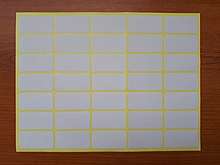Adhesive label
An adhesive label or sticky label is a small piece of paper designed to be affixed to another larger piece of paper or other object, typically by the action of a layer of adhesive on the back of the label.
.jpg)
Name tag labels
The most familiar type of label is the postage stamp, which was developed in the mid-19th century. In 1935, R. Stanton Avery invented a machine to make self-adhesive labels.[1]

A sheet containing adhesive labels
The concept has since been extended into a variety of areas:
- On mail:
- airmail etiquettes
- charity labels
- address labels
- return address labels
- postage meter labels
- certain types of postal labels
- On other kinds of paper objects:
- revenue stamps
- savings stamps
- general markers, notices, or warnings
Almost every imaginable type of paper and adhesive has been used at some point; see postage stamp paper and postage stamp gum for a more detailed discussion. Label may be produced individually, or in sheets, which case they are usually separated by perforations or rouletting, see postage stamp separation.
See also
Notes
- R. Stanton Avery, 90, Inventor and Producer of Self-Sticking Labels, Dec. 22, 1997, The New York Times
External links
| Wikimedia Commons has media related to Adhesive labels. |
- The history of self adhesive labels, WorldLabel.com
- THE HISTORY OF SELF ADHESIVE LABELS, Etiquette.co.uk
This article is issued from Wikipedia. The text is licensed under Creative Commons - Attribution - Sharealike. Additional terms may apply for the media files.